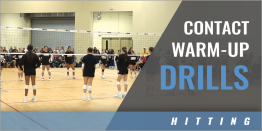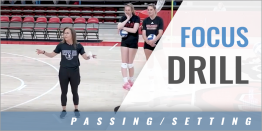| Looking for Inspiration? Look at the Best! |
| By: Jim Miret - Front Range Volleyball
Originally Published in: Coaching Volleyball Copyright and Provided by: AVCA Growing up in the 70's, I watched a lot of professional basketball. As a Denver native, I watched Denver Rockets games (then a member of the American Basketball Association league and a team that would later become the Denver Nuggets) on local television, which displayed a type of play vastly different to the NBA play of the 70's. The ABA was known for a flashy, freewheeling style of play that showcased the talent and athleticism of their players. When the ABA merged with the NBA in 1976, the NBA began a shift towards this more athletic and entertaining style of play. This merger increased television coverage of professional basketball - which gave young players like me access to professional models of the sport. I remember going to the local middle school blacktop with my friends to play pickup basketball. We all yearned to imitate the moves we saw on television from our favorite professional basketball players. Speeding around the court and killing it on that nine-foot rim, we would do our best imitations of the "Tomahawk", "Windmill" and the "360 Dunk". Obviously, we could not fly through the air like Doctor J, and we couldn't dunk like Moses Malone or pass with the creativity of Rick Barry. But, we went out on that blacktop everyday and we tried. And by doing so we engaged our athleticism and our creativity, and it sparked a deep sense of enjoyment. During this same time period, I was also watching college basketball. Many coaches were employing a tactic called the "4 corners" offense or the "stall." This style of basketball was boring to watch as a spectator, and would eventually spur the conception of the "shot clock" in the '85-'86 season, which introduced speed and athleticism back into the game. Many college coaches did not like the ABA style of play, and argued that dunking was "not a skillful shot." (Dunking in the NCAA was outlawed from 1968 to 1976.) Eventually the influence of the NBA seeped into basketball at all levels, and now we see arguably some of the best athletes on the planet playing a fast, dynamic and skillful game that is equally entertaining to watch. Now, you might be asking yourself - how does this relate to volleyball? In observing the evolution of basketball that occurred through the ABA and the NBA merger, it's my opinion that we should look to professional models of volleyball for inspiration and evolution in our sport's future. Within the realm of volleyball, the most elite and exciting play is happening internationally. Thanks to technological developments and the growth in popularity of volleyball, international game film is more available than ever before on many media platforms. Exposing our young players to elite volleyball players exhibiting superior athleticism and skill, and teams with different styles of offense and tempo that we see internationally, would inspire them to go out and experiment on their own blacktops, per se. As Head Coach of the USA Youth National Team from 1998 to 2002, one of the first tasks I assigned my players was to have them look at video from several senior national teams and report back to our team about what they observed. They watched video on Russia, Cuba, Italy, China, Japan and other top women's volleyball teams. I wanted to open their minds to different tactics and techniques that were being implemented by the best players around the world. I wanted them to understand that there was more than one way to play volley-ball. And most importantly, I wanted them to see that the game at its highest level was played with power, precision, athleticism and creativity. I consider myself a technician when it comes to teaching skills in volleyball. But my criteria is this: is the skill biomechanically efficient and is the movement being done in such a way as to decrease the probability for injury? In this pursuit I have learned from physical therapists, athletic trainers and other people with advanced degrees in Exercise Science and Biomechanics. If I have a question, I ask someone who has the expertise I am seeking. I will be writing about some of this in future articles. I often hear coaches say they don't have the athletes to justify training the high-level skills we see exhibited by the best players in the world. The solution these coaches create is to teach different skills - skills their athletes can "handle." So, if in your opinion I don't have the athletic ability of Olympic sprinter Usain Bolt, you would not teach me to sprint? Or, would you teach me to sprint on my knees because I lack Usain's talent? Think critically about the coaching and development of your own teams and players - are you teaching the "4 corners" version of volleyball, or are you challenging your players to be athletic and realize their potential? Why limit our athletes? Why not challenge them! Don't we want our athletes to fully express their athleticism and creativity? Don't we want athletes who achieve to be highly skilled players? And why not challenge our own views of what's possible with our players? We should look at the best international players and teams in the world and study their techniques and tactics. Look at Lonneke Sloetjes and Laura Dijkema of Nederlands, Natalia Pereira and Dani Lins of Brazil, Zhu Ting and Xia Ding of China, Brankica. Mihajlovic of Serbia, as well as top USA players like Jordan Larson, Alicia Glass, Lindsey Berg and Foluke Akinradewo. Observe how they pass, attack, block, defend and set. Do these skills look different from the way you're teaching? Probably - but aren't they just as, if not more, effective? Challenge yourself to learn a skill in a new way. Progress doesn't just take time - it also takes people who are willing to be challenged day after day because they know that is the path to greatness. |







